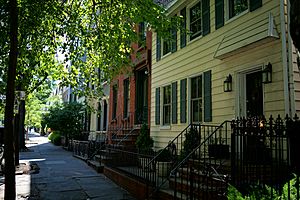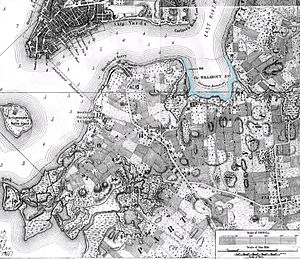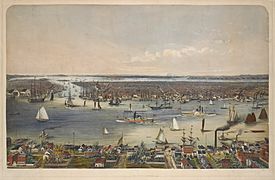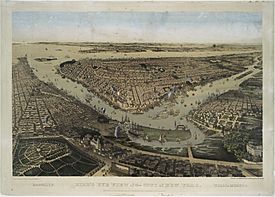Wallabout Bay facts for kids

Wallabout Bay is a small part of the water in Upper New York Bay. It's located along the northwest coast of Brooklyn, a borough of New York City. You can find it between the Williamsburg Bridge and the Manhattan Bridge. Across the East River to the west, it faces a spot in Manhattan called Corlear's Hook. Today, Wallabout Bay is home to the famous Brooklyn Navy Yard.
Right next to the bay is the Wallabout neighborhood. This area has been around since the 1600s. It's a mix of old wooden houses, public housing, brick townhouses, and warehouses. A special old house, the Lefferts-Laidlaw House, is located here. It was added to the National Register of Historic Places in 1985 because of its history.
The name of this curved bay comes from the Dutch words "Waal bocht." This means "Walloons' Bend." It was named after the first European settlers in the area, who were called Walloons. They came from a place that is now called Wallonia.
Contents
History of Wallabout Bay
The Wallabout area was first settled by Europeans in the early 1630s. Several families of French-speaking Walloons bought land there. They had arrived in New Netherland (which was what New York was called then) in the 1620s from Holland.
Settlement really began in the mid-1630s. A man named Joris Jansen Rapelje traded goods with the Canarsee Native Americans. He got about 335 acres (1.36 square kilometers) of land at Wallabout Bay. However, Rapelje and other early settlers waited about ten years to move there full-time. They waited until problems with the Native American tribes were solved.
Most history books say that Rapelje's house was the very first house built at Wallabout Bay. His daughter, Sarah, was the first child born in New Netherland to European parents. Rapelje later became a magistrate (a type of judge) in Brooklyn. He was also part of a group called the Council of Twelve Men.
Rapelje's son-in-law, Hans Hansen Bergen, owned a large piece of land next to Rapelje's. Nearby, other farmers like Jan and Pieter Monfort and Peter Caesar Alberto had tobacco farms.
Starting in 1637, the Wallabout Bay became the spot for the first ferry across the East River. This ferry connected Brooklyn to lower Manhattan. The only ferryman, Cornelis Dircksen, farmed land on both sides of the river. This helped him use his time well while waiting for passengers. The Brooklyn Bridge now stands near where this ferry used to run.
In 1638, a old system of land ownership called "feudal" was stopped. The small settlement then became a colony of "freeholders." This meant that after ten years of giving a small part of their crops to the Dutch East India Company, the colonists would own their farmland. This small colony at Wallabout grew and became the city of Brooklyn.
Revolutionary War Prison Ships
During the American Revolutionary War (from about 1776 to 1783), the British kept their prison ships anchored in Wallabout Bay. The most well-known of these was HMS Jersey.
It is believed that around 12,000 prisoners of war died on these ships by 1783. Many died because they were not cared for properly. Some were buried in shallow graves along the eroding shore. Often, their bodies were simply thrown into the water. The Prison Ship Martyrs' Monument was built in nearby Fort Greene to honor these people. This monument holds some of the prisoners' remains.
Over time, Wallabout Bay became the location for the Brooklyn Navy Yard. Parts of the bay were filled in with land to make the navy yard bigger. In the late 1800s, this filling created a small island. Later, even more land was added, connecting this island to the mainland.
What's in a Name: Wallabout Bay Etymology
The name "Wallabout Bay" has an interesting history. Gabriel Furman, in his book from 1824, explained that the name comes from the Dutch words "Waal bocht." This means "bay (or bend) of the Walloons." It refers to the original French-speaking settlers who lived in the area.
Another idea is that the name comes from the River Waal. This river is an important waterway in the Netherlands. It was often called an "inner harbor." This idea fits because Wallabout Bay is like an inner harbor for the larger New York Bay.
|
See also
 In Spanish: Bahía de Wallabout para niños
In Spanish: Bahía de Wallabout para niños





